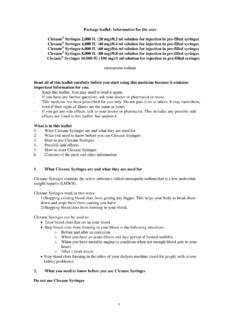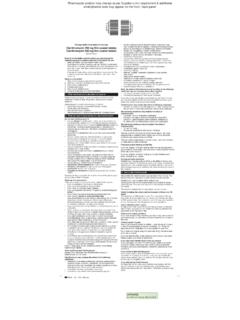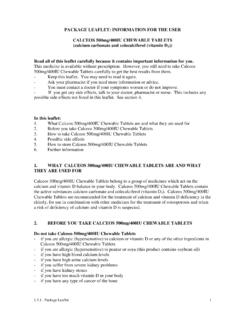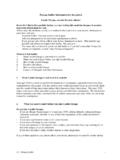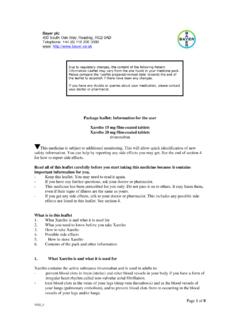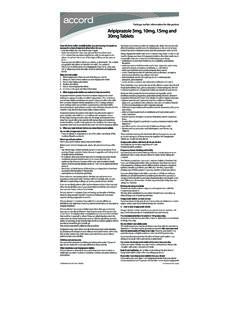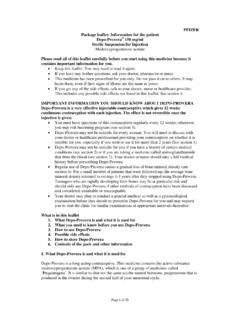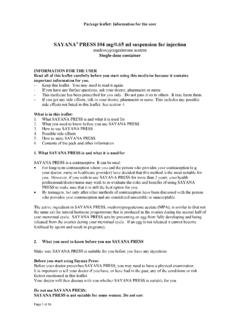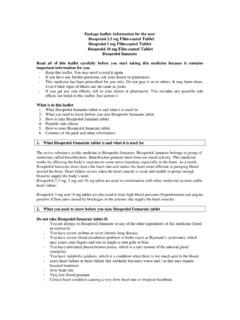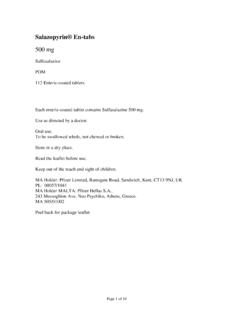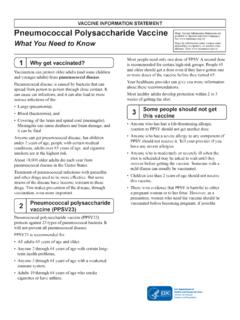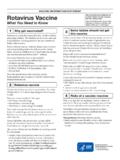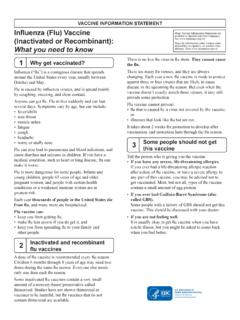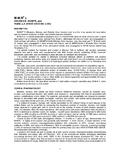Transcription of PACKAGE LEAFLET: INFORMATION FOR THE USER
1 1/6 PACKAGE leaflet : INFORMATION for the user REVAXIS Suspension for injection in pre-filled syringe Diphtheria, Tetanus and Poliomyelitis (inactivated) vaccine (adsorbed, reduced antigen(s) content) Read all of this leaflet carefully before you or your child is vaccinated because it contains important INFORMATION for you. - Keep this leaflet . You may need to read it again. - If you have any further questions, ask your doctor, pharmacist or nurse. - This vaccine has been prescribed for you or your child. Do not pass it on to others. - If you or your child get any side effects, talk to your doctor, pharmacist or nurse. This includes any possible side effects not listed in this leaflet . See section 4. What is in this leaflet : 1. What REVAXIS is and what it is used for 2. What you need to know before you use REVAXIS 3. How to use REVAXIS 4. Possible side effects 5. How to store REVAXIS 6.
2 Contents of the pack and otherinformation 1. What REVAXIS is and what it is used for REVAXIS is a vaccine . Vaccines are used to protect against infectious diseases. This vaccine helps boost protection against diphtheria, tetanus and poliomyelitis (polio). When an injection of REVAXIS is given, the body s natural defences will produce protection against these different diseases. This booster vaccination is for children from the age of 6 years, teenagers and adults who have received this vaccine or a similar vaccine in the past. REVAXIS should not be given as the first vaccination (primary course) against diphtheria, tetanus and poliomyelitis (polio). REVAXIS will be given according to national recommendations and/or local practice. 2. What you need to know before you use REVAXIS To make sure that REVAXIS is suitable for you or your child, it is important that you tell your doctor, nurse or pharmacist if any points below apply to you or your child.
3 If there is anything you do not understand, ask your doctor, nurse or pharmacist to explain. Do not use REVAXIS if you or your child are allergic (hypersensitive) to the active substances of REVAXIS ( listed in section 6). to any of the other ingredients (listed in section 6). -to neomycin, streptomycin and polymyxin B which can be present in trace amounts if you or your child have ever had an allergic reaction to any vaccine for diphtheria, tetanus or polio. if you or your child have ever had any neurological problems (such as weakness or numbness) after a previous injection of a vaccine against diphtheria or tetanus. 2/6 if you or your child have an acute severe illness (infection) with a high temperature. The vaccination will be delayed until you/your child has recovered. A minor infection is not usually a reason to postpone vaccination. Your doctor or nurse will decide if you or your child should receive the vaccine .
4 Warnings and precautions Talk to your doctor, pharmacist or nurse before using REVAXIS if you or your child have a blood disorder where you or your child bruise or bleed easily (such as haemophilia or thrombocytopenia). if you or your child have ever had a temporary loss of movement and feeling in all or part of the body or loss of movement, pain and numbness of the arm and the shoulder after having a vaccine which contains tetanus (Guillain-Barr syndrome or brachial neuritis). if you or your child have had a vaccine for diphtheria or tetanus within the last 5 years. Your doctor will decide on the basis of local recommendations whether you or your child can receive a further injection or not. If you or your child have a poor or reduced immune system, because of a course of medical treatment ( , steroids, chemotherapy or radiotherapy), HIV infection or any other illness. The vaccine may not protect as well as it protects people with normal immune systems.
5 The vaccination may be postponed until your/your child's immune system has recovered. Other medicines and REVAXIS REVAXIS can be given at the same time as other vaccines or immunoglobulins but in different injection sites ( the other arm or leg). If you or your child are receiving medical treatment that affects the immune system (such as steroids, chemotherapy or radiotherapy), refer to the section "Take special care with REVAXIS". Tell your doctor, nurse or pharmacist if you are using or have recently used any other medicines Pregnancy, breast-feeding and fertility If you or your child are pregnant or breast-feeding, think you or your child may be pregnant or are planning to have a baby, ask your doctor or pharmacist for advice whether you or your child should receive the vaccine . REVAXIS can be given to women who are breastfeeding. Driving and using machines Dizziness (vertigo) has been reported after vaccination.
6 If you feel dizzy after having the vaccine , you should not drive or operate machinery. 3. How to use REVAXIS When you or your child will be given the vaccine REVAXIS is for children from the age of 6 years, teenagers and adults. This vaccine is not suitable for children who are under 6 years old. REVAXIS is used to boost protection in someone who has received this vaccine or a similar vaccine in the past. Remember that the polio vaccine you had in the past may have been given by injection or by mouth. 3/6 This vaccine will be given according to national recommendations and/or local practice. After an injury, you may need a tetanus vaccination. Your doctor or nurse will give you REVAXIS in case you also need a booster against diphtheria and polio at the same time. Dosage and method of administration The vaccination will be given by a doctor or nurse who is trained in the use of vaccines and at a clinic or surgery that is equipped to deal with any uncommon severe allergic reaction to the injection.
7 Dosage Children from the age of 6 years, teenagers and adults will receive one injection ( ml dose). Method of administration REVAXIS is given as an injection into a muscle, usually in the upper outer part of the arm. The vaccine is not to be injected directly into any blood vessel or into the skin. In case of blood clotting disorders your doctor may decide to inject deep under the skin. If you have any further questions on the use of this vaccine , ask your doctor, nurse or pharmacist. 4. Possible side effects Like all medicines and vaccines, this vaccine can cause side effects, although not everybody gets them. Serious allergic reactions These reactions are always a rare possibility after receiving a vaccine and may include: difficulty in breathing blue discolouration of the tongue or lips swelling of the face or throat low blood pressure (causing dizziness) fainting (collapse) When these signs or symptoms occur they usually develop very quickly after the injection is given and while the person affected is still in the clinic or doctor s surgery.
8 If any of these symptoms occur after leaving the place where you or your child received the injection, you must consult a doctor IMMEDIATELY. Other side effects If you or your child experience any of the following side effects and it gets serious, tell your doctor, nurse or pharmacist. During clinical studies, the following side effects were observed: Very common side effects (reported in more than 1 out of 10 people): local reactions at the site of injection: pain, redness, hardening of the skin (induration), swelling or nodule. If these symptoms begin it is usually within 48 hours of the vaccination, lasting for 1 to 2 days. Common side effects (reported by less than 1 in 10 people): dizziness (vertigo) 4/6 feeling sick and being sick (nausea and vomiting) a high temperature ( fever) headache Uncommon side effects (reported by less than 1 in 100 people): swollen glands (lymphadenopathy) feeling generally unwell (malaise) muscle pains (myalgia) Rare side effects (reported by less than 1 in 1,000 people): joint pains (arthralgia) Additionally, the following side effects with unknown frequency (exact incidence rates cannot be precisely calculated) have been reported during the commercial use of REVAXIS pain in the vaccinated limb large reactions at the injection site (larger than 5 cm), including extensive limb swelling from the injection site beyond one or both joints.
9 These reactions start within 24-72 hours after vaccination, may be associated with redness, warmth, tenderness or pain at the injection site, and get better within 3-5 days without the need for treatment. uncontrollable shivering (chills) and flu-like symptoms. These side effects mostly occur on the same day as the vaccination. feeling weak and looking pale (asthenia, pallor). This usually goes away within a few days of the vaccination abdominal pain, diarrhoea allergic reactions such as hives or skin rash, swelling of the face (facial oedema) serious allergic reactions including shock (anaphylactic reactions including shock). Please refer to the paragraph "Serious allergic reactions" earlier in this section. fainting (vasovagal syncope) pins and needles or numbness in the vaccinated limb (transient paresthesia and hypoesthesia) temporary loss of movement or feeling (Guillain-Barr syndrome); loss of movement, pain and numbness of the arm and the shoulder (brachial neuritis); convulsions.
10 If any of the side effects gets serious, or if you notice any side effects not listed in this leaflet , please tell your doctor, nurse or pharmacist. Reporting of side effects in the UK If you get any side effects, talk to your doctor or pharmacist. This includes any possible side effects not listed in this leaflet . You can also report side effects directly via the Yellow Card Scheme at By reporting side effects you can help provide more INFORMATION on the safety of this medicine. Reporting of side effects in Ireland If you get any side effects, talk to your doctor or pharmacist. This includes any possible side effects not listed in this leaflet . You can also report side effects directly via HPRA Pharmacovigilance, Earlsfort Terrace, IRL Dublin 2; Tel: +353 1 6764971; Fax: +353 1 6762517; Website: ; E-mail: By reporting side effects you can help provide more INFORMATION on the safety of this medicine.
